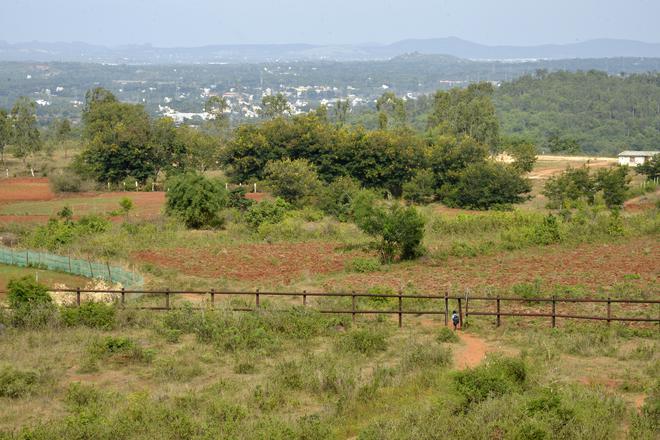Less than 100 metres wide at many stretches, can the Bannerghatta National Park (BNP) accommodate a massive six-lane flyover without posing a severe threat to its wildlife and ecosystem? Its buffer zone already shrunk, can the endangered green space be protected from the latest onslaught by exploring alternative alignments to the proposed Satellite Township Ring Road (STRR)?
Planned to be built on the 3.85km stretch of the existing road linking Bannerghatta and Jigani Road, the flyover project has unleashed a storm of concern among environmentalists and wildlife conservationists. The National Highways Authority of India (NHAI) says it will install effective noise barriers and restrict construction hours. But will these be enough to address the grave risks posed both in the short and long terms?
Severe threat of fragmentation
Faced with very high man-animal conflict and encroachments, BNP is already reeling under severe threats of fragmentation, reminds conservationists. “The Park has a unique distinction of hosting large mammals including the tiger, elephant, gaur, dholes and others right at the edge of a metropolis. Though it is connected to Cauvery Wildlife Sanctuary in Karnataka and Tamil Nadu, the national park is a very linear protected area with several parts of the forest area already used for tourism, zoo and other activities,” notes conservation biologist Sanjay Gubbi.
This mandates extremely effective mitigation measures. “It needs to be ensured that the measures are planned and designed based on scientific studies and not on an ad-hoc basis. It should involve a good understanding of wildlife movement patterns especially that of elephants,” he points out.
Habitat reduction
But the flyover project runs counter to this rationale. Sanjay explains, “This new road project will reduce the habitat available for elephants and increase the conflict in the long run as there are nearly 100 elephants that use the landscape. For sustainable development we really need to zone our landscapes and earmark where wildlife gets priority and where development gets importance.”
Strategically located on the Northern side of Mysore Elephant Reserve, Bannerghatta park also serves as a critical link for the migration of elephants from the Cauvery Wildlife Sanctuary in Krishnagiri and the Hosur Forest division in Tamilnadu. Geographically, the park is also a key watershed for streams such as Rayathmala Hole, Muthyala Madu halla, Antaragange Hole and rivers Arkavathi and Suvarnamukhi.
In March 2020, the Centre had reduced the eco-sensitive zone (ESZ) around BNP by 100 sqkm. The zone area shrank to 168.84 sqkm from 268.9 sqkm, earmarked by a 2016 notification. Commercial mining, stone quarrying and setting up of crushing units are effectively banned within the ESZ.
Early warnings
By 2008 itself, an Indian Institute of Science (IISc) Centre for Ecological Sciences (CES) study had found about 120 human settlements within five kilometres km from the BNP boundary and five human settlements within BNP. Many of the settlements formed thereafter were through encroachments of forest lands. Tribes dominate the settlements located close to the park boundary in the South-East, and South-West and depend on agriculture and livestock rearing for livelihood.
The study’s projected land use of 2027 depicted the loss of forest cover from 41.38 to 35.59% and an increase in urban area from 4.49 to 9.62 % due to various layouts in the periphery. Barren land area showed a reduction from 4.17 to 3.36 % by conversion of open spaces to urban. “The forest cover present in southern parts represents minimal disturbances (connected to Tali reserve forest and Cauvery wildlife sanctuary) while the Northern portion shows more transitions,” the study noted.
In a clear warning, the study said, “The uncontrolled and unplanned growth of greater Bangalore would have an irreversible impact on forests of BNP. The regions of Koli Farm gate, Batterayana Doddi village, Weavers colony, Kalkere region and Bannerghatta village, Anekal road represents higher loss in forest cover due to new paved surfaces created in the form of townships. The barren lands and fallow lands near to state highways and major roads were converted as layouts resulting in creating new agriculture areas in gomala and other fragmented forests.”
“The flyover project will aggravate the human-animal conflict. We are shrinking their habitat and making them more and more vulnerable. That is why we need to be really careful about this project. Leopards, for instance, keep straying into settlements. Then people become more reactive and start killing, or demand like in Wayanad to start culling. It is so unrealistic,” says Dr. T.V. Ramachandra, who anchored the study along with his team.

No scientific basis
Alternatives to the road through the park are indeed possible. But, as he points out, “We don’t have a scientific basis in designing or formulating the project. We implement it because large amounts of money are involved.”
Flyover projects do exist in other forested areas. But there is a difference here, as Sanjay reiterates. “The experience in other forests has been mixed. When highways are made in forests that are vast in size, then a flyover may be the only solution. However, Bannerghatta is a very narrow stretch of forest. That is the concern. Anything like this is going to affect the animals.”
Dr. Ramachandra draws attention to other problems related to vehicular emissions. “During the construction stage too, there will be impact while erecting pillars and more. Besides, there are issues linked to climate change. The Park acts as a carbon sink for Bengaluru. More than 1,200 deciduous trees will be lost and there are many medicinal plants too,” he explains.
An elevated flyover inside the park will effectively bypass villages that are inside Bannerghatta that rely on road connectivity, says Sanjay. “I don’t know how they will address this by providing connectivity. That is something which only the Detailed Project Report (DPR) can tell us.”
The State Wildlife Board has already cleared the project. Questions are now being raised whether it explored other alternatives. As an insider indicates, the proposals are usually not circulated in advance to the members to help them understand and deliberate on it. “Agenda is given in the meeting, so nobody has a clue about anything,” the insider says, preferring anonymity.







